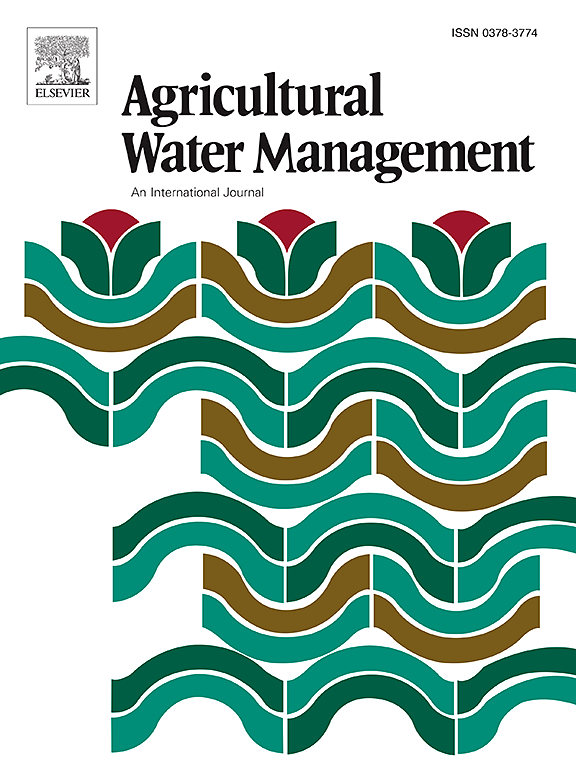非连续改良地下排水防治内涝的现场及数值评价
IF 6.5
1区 农林科学
Q1 AGRONOMY
引用次数: 0
摘要
由于耕地的短缺,地下排水系统正在逐步取代最底层的明渠,这代表了中国水资源管理实践的新趋势。虽然地下排水系统旨在消除内涝,但其解决地表积水的效果从根本上受到土壤渗透性的限制。为了解决这个问题,提出了一种不连续的改进地下排水(DISD),其特点是从管道延伸到土壤表面的不连续过滤器。通过现场和数值试验对该系统的除涝和控制地下水的性能进行了评价。基于经过校准和验证的HYDRUS-3D模型,模拟了过滤器高度、过滤器宽度、过滤器间距和泄油间距的变化。结果表明,在地表积水和短时强降水条件下,DISD在降低地下水位的效果优于CSD(常规地下排水)。田间试验结果表明,短期排水时,DISD的累积流量约为CSD的2 ~ 2.3倍,长期排水时,其累积流量约为CSD的1.37倍。数值模拟结果表明,当砂石滤网长度为0.2 ~ 4 m,滤网宽度为1.2 m时,地表积水时,DISD的排水量是CSD的1.91 ~ 5.40倍。当DISD滤水体积大于ISD滤水体积的6% %时,DISD滤水去除地表内涝的效果优于ISD(改良地下排水)。DISD在控制地下内涝方面也优于ISD。这些研究成果为DISD的设计提供了科学依据,并为其在中国的广泛应用奠定了坚实的基础。本文章由计算机程序翻译,如有差异,请以英文原文为准。
Field and numerical evaluation of discontinuous improved subsurface drainage for waterlogging control
Due to the shortage of farmland, subsurface drainage systems are progressively replacing the lowest-level open ditches, representing an emerging trend in water management practices in China. While subsurface drainage systems are engineered to remove waterlogging, their efficacy in resolving surface ponding is fundamentally constrained by soil permeability. To address this issue, a discontinuous improved subsurface drainage (DISD) has been proposed, featuring discontinuous filter extending from the pipe to the soil surface. Field and numerical experiments have been conducted to evaluate the performance of this proposed system on waterlogging removal and groundwater control. Based on a calibrated and validated HYDRUS-3D model, the simulations involved variations in filter heights, filter widths, filter spacings, and drain spacings have been conducted. The results indicated that DISD exhibited superior performance under conditions of surface ponding and short-duration heavy rainfall, enhanced efficiency in lowering the groundwater table compared to CSD (conventional subsurface drainage) for shallow groundwater table situation. Field experiments revealed that the cumulative discharge of DISD was approximately 2–2.3 times higher than CSD for short-term drainage and 1.37 times higher for long-term drainage. Numerical simulations showed that with a sand-gravel filter length ranging from 0.2 m to 4 m and a filter width of 1.2 m, the drainage discharge of the DISD was 1.91–5.40 times of CSD when surface ponding occurred. DISD is outperformed than ISD (improved subsurface drainage) in removing surface waterlogging when the filter volume of DISD is more than 6 % of ISD. DISD also does better in subsurface waterlogging control than ISD. These research findings provide a scientific basis for designing DISD and lay a solid foundation for their broader application in China.
求助全文
通过发布文献求助,成功后即可免费获取论文全文。
去求助
来源期刊

Agricultural Water Management
农林科学-农艺学
CiteScore
12.10
自引率
14.90%
发文量
648
审稿时长
4.9 months
期刊介绍:
Agricultural Water Management publishes papers of international significance relating to the science, economics, and policy of agricultural water management. In all cases, manuscripts must address implications and provide insight regarding agricultural water management.
 求助内容:
求助内容: 应助结果提醒方式:
应助结果提醒方式:


